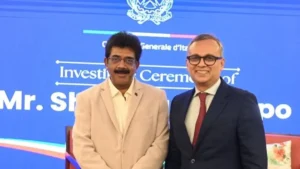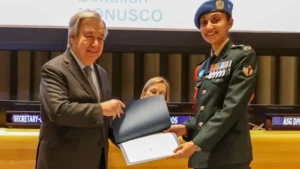In 2024, the Nobel Assembly at the Karolinska Institute in Stockholm announced that Victor Ambros and Gary Ruvkun had been awarded the prestigious Nobel Prize in Medicine. Their groundbreaking work, recognized for its profound implications in the field of molecular biology, centered on the discovery of microRNA (miRNA) and its crucial role in post-transcriptional gene regulation.
Name of winners : Victor Ambros and Gary Ruvkun (Jointly)
Topic : For the discovery of microRNA and its role in post-transcriptional gene regulation
General Facts
- The information stored within our chromosomes can be likened to an instruction manual for all cells in our body.
- Every cell contains the same chromosomes, so every cell contains exactly the same set of genes and exactly the same set of instructions.
- Yet, different cell types, such as muscle and nerve cells, have very distinct characteristics. Every time depending on situations differences arise.
- So, gene regulation, which allows each cell to select only the relevant instructions.
- This ensures that only the correct set of genes is active in each cell type.
Their Discovery
- Victor Ambros and Gary Ruvkun were interested in how different cell types develop.
- They discovered microRNA, a new class of tiny RNA molecules that play a crucial role in gene regulation.
- Their groundbreaking discovery revealed a completely new principle of gene regulation that turned out to be essential for multicellular organisms, including humans.
- It is now known that the human genome codes for over one thousand microRNAs.
- Their surprising discovery revealed an entirely new dimension to gene regulation.
- MicroRNAs are proving to be fundamentally important for how organisms develop and function.
Key Points on Gene Regulation
Flow of Genetic Information:
- DNA to mRNA to Protein.
- Genetic information is stored in DNA.
- DNA is transcribed into messenger RNA (mRNA) in a process called transcription. mRNA is then translated into proteins, which are responsible for carrying out cellular functions according to the genetic instructions.
Identical Genetic Information in All Cells
- All cells in the body contain the same set of genetic instructions in their DNA, regardless of their type (e.g., muscle, nerve, intestinal cells).
Unique Protein Expression in Different Cells
- Despite having identical DNA, different cell types express unique sets of proteins.
- This difference is due to the precise regulation of gene activity, which ensures only the relevant genes are active in each cell type.
Specialized Cellular Functions
- Gene regulation enables specific cell types (muscle, nerve, intestinal) to perform their specialized functions by activating only the necessary genes.
Adaptation to Changing Conditions
- Gene regulation is a dynamic process that allows cells to adjust their gene activity in response to changes in the body and the environment.
- This fine-tuning is essential for maintaining normal cellular function and health.
Their Research
- In Horvitz’s laboratory, they studied a relatively unassuming 1 mm long roundworm, C. elegans.
- Despite its small size, C. elegans possesses many specialized cell types such as nerve and muscle cells also found in larger, more complex animals, making it a useful model for investigating how tissues develop and mature in multicellular organisms.
Study of Two Mutants
- They studied two mutant strains of worms, lin-4 and lin-14, that displayed defects in the timing of activation of genetic programs during development.
- They wanted to identify the mutated genes and understand their function.
Victor’s Research
- Victor Ambros analyzed the lin-4 mutant and Methodical mapping allowed the cloning of the gene and led to an unexpected finding.
- The lin-4 gene produced an unusually short RNA molecule that lacked a code for protein production.
- These surprising results suggested that this small RNA from lin-4 was responsible for inhibiting lin-14.
Gary’s Research
- Gary Ruvkun investigated the regulation of the lin-14 gene, Unlike how gene regulation was then known to function, Ruvkun showed that it is not the production of mRNA from lin-14 that is inhibited by lin-4.
- The regulation appeared to occur at a later stage in the process of gene expression, through the shutdown of protein production.
- Experiments also revealed a segment in lin-14 mRNA that was necessary for its inhibition by lin-4.
Compared the findings
- The two laureates compared their findings, which resulted in a breakthrough discovery.
- The short lin-4 sequence matched complementary sequences in the critical segment of the lin-14 mRNA.
- Ambros and Ruvkun performed further experiments showing that the lin-4 microRNA turns off lin-14 by binding to the complementary sequences in its mRNA, blocking the production of lin-14 protein.
- A new principle of gene regulation, mediated by a previously unknown type of RNA, microRNA, had been discovered.
- The results were published in 1993 in two articles in the journal Cell.
Ambros and Ruvkun’s seminal discovery in the small worm C. elegans was unexpected, and revealed a new dimension to gene regulation, essential for all complex life forms.
About Victor Ambros
- Victor Ambros was born in 1953 in Hanover, New Hampshire, USA.
- He received his PhD from Massachusetts Institute of Technology (MIT), Cambridge, MA, in 1979 where he also did postdoctoral research 1979-1985.
- He became a Principal Investigator at Harvard University, Cambridge, MA in 1985.
- He was Professor at Dartmouth Medical School from 1992-2007 and he is now Silverman Professor of Natural Science at the University of Massachusetts Medical School, Worcester, MA.
About Gary Ruvkun
- Gary Ruvkun was born in Berkeley, California, USA in 1952.
- He received his PhD from Harvard University in 1982.
- He was a postdoctoral fellow at Massachusetts Institute of Technology (MIT), Cambridge, MA, 1982-1985.
- He became a Principal Investigator at Massachusetts General Hospital and Harvard Medical School in 1985, where he is now Professor of Genetics.
About Nobel Prize
History
- The Nobel Prize was set up when businessman and entrepreneur Alfred Nobel died and left the majority of his fortune to the establishment of prizes in physics, chemistry, physiology or medicine, literature and peace.
- His will stated that the prizes should be awarded to “those who, during the preceding year, shall have conferred the greatest benefit to humankind.”
Who was Alfred Nobel?
- Alfred Nobel was an inventor, entrepreneur, scientist and businessman who also wrote poetry and drama.
- His varied interests are reflected in the Nobel Prizes which he laid the foundation for in 1895 in his last will and testament.
Award History
- The first Nobel Prizes were awarded in 1901 and they have been awarded annually since then.
- There have been years in that time when the Nobel Prizes have not been awarded - mostly during World War I (1914–1918) and II (1939–1945).
Categories
- The Nobel Prize categories are,
- physics, chemistry, physiology or medicine, literature and peace – these were laid out in the will of Alfred Nobel.
- In 1968, Sveriges Riksbank Established the Sveriges Riksbank Prize in Economic Sciences in Memory of Alfred Nobel.
- Sveriges Riksbank is the Swedish Central Bank.
Noble awarded in Norway
- In his will Alfred Nobel laid out who he wanted to be responsible for the selection of the Nobel Prize laureates.
- The prizes were to be awarded by Swedish institutions – apart from the peace prize, whose award was to be decided by a committee of five persons elected by the Norwegian Parliament.
- During Nobel’s lifetime Sweden and Norway were joined in a union but we still don’t know exactly why Alfred Nobel chose for the peace prize to be awarded in Norway.
- However as the prize committee is located in Oslo, it follows that the prize is also awarded there.
Prize Money
- The income from the investments was to be “distributed annually in the form of prizes to those who during the preceding year have conferred the greatest benefit to humankind.”
- The Nobel Prize amount for 2024 is set at Swedish kronor (SEK) 11.0 million per full Nobel Prize.
Why are they called Nobel Prize laureates?
- The word “laureate” refers to being signified by the laurel wreath. In ancient Greece, laurel wreaths were awarded to victors as a sign of honor.
- Put that together with the Nobel Prize and we get “Nobel Prize laureate”.
How many people can share the same Nobel Prize?
- A Nobel Prize can be shared by up to three individuals, or in the case of the peace prize, it can also be awarded to an organization.
- The rule that a prize can only be awarded to three people comes from the statutes of the Nobel Foundation, which is responsible for fulfilling the intentions of Nobel’s will.
- It specifically states: “In no case may a prize amount be divided between more than three persons.”
Can award a prize posthumously?
- A Nobel Prize cannot be awarded posthumously.
- However, since 1974, if the recipient dies after the prize has been announced they can still be awarded it.
Who selects the Nobel Prize laureates?
In his last will and testament, Alfred Nobel specifically designated the institutions responsible for the prizes he wished to be established.
- The Royal Swedish Academy of Sciences for the Nobel Prize in Physics and Chemistry
- Karolinska Institutet (now The Nobel Assembly at Karolinska Institutet) for the Nobel Prize in Physiology or Medicine
- The Swedish Academy for the Nobel Prize in Literature
- A committee of five persons to be elected by the Norwegian Parliament (Storting) for the Nobel Peace Prize.
- The Sveriges Riksbank Prize in Economic Sciences in Memory of Alfred Nobel was instituted in 1968, on the tercentenary of the bank.
| Summary/Static | Details |
| Why in the news? | Nobel Winner Medicine |
| Nobel Prize in Medicine 2024 | Victor Ambros and Gary Ruvkun (Jointly) |
| Discovery | Discovery of microRNA (miRNA) and its role in post-transcriptional gene regulation. |
| Key Contribution | Identified how microRNA regulates gene expression by binding to messenger RNA (mRNA) and preventing protein production. |
| Research Focus | Investigated gene regulation in C. elegans (roundworm), focusing on mutants lin-4 and lin-14. |
| Significance | Revealed a new layer of gene regulation essential for multicellular organisms, including humans. |
| MicroRNA Discovery | Small RNA molecules (microRNAs) regulate genes by interacting with mRNA to block protein production, affecting cell differentiation and function. |
| Victor Ambros | Born: 1953, Hanover, USA. PhD from MIT. Professor at University of Massachusetts Medical School. |
| Gary Ruvkun | Born: 1952, Berkeley, USA. PhD from Harvard University. Professor of Genetics at Massachusetts General Hospital. |
| About Nobel Prize | Established by Alfred Nobel (1895). Awarded for contributions that “confer the greatest benefit to humankind.” |
| Prize Money | 2024 Nobel Prize value: SEK 11.0 million per full Nobel Prize. |
| Nobel Prize Categories | Physics, Chemistry, Physiology/Medicine, Literature, Peace (and Economics since 1968). |




 Italy Honours Goa Industrialist Shriniva...
Italy Honours Goa Industrialist Shriniva...
 Indian Army Major Swathi Shantha Kumar W...
Indian Army Major Swathi Shantha Kumar W...
 Oscars 2026: Five Indian Films Eligible ...
Oscars 2026: Five Indian Films Eligible ...







